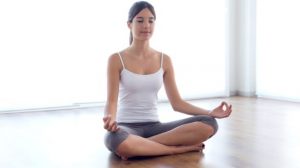Kapalbhati involves deliberate and vigorous exhalation to help your heart resist blockages
Inhale Deeply and Exhale Vigorously.
How to Do Kapalbhati
Start with a deep inhalation of air and wait for a few seconds. Once you feel comfortable and are ready to exhale, do not exhale in the normal manner, but force the air in your lungs out with a snort. Follow up the first snort with repeated and vigorous snorts of exhalation. You will find yourself getting breathless after a few repeated exhalations. The number of times you can exhale this way depends on your comfort level. There is no standard number of exhalations for every person. So keep exhaling till you feel breathless and are no longer comfortable to exhale.
Draw Your Cheeks Inside While Inhaling
Now once again inhale air forcefully. While inhaling draw your cheeks inside your mouth to give that added power to your inhalation. Repeat the same cycle of holding the inhaled air for some seconds within your lungs and start the process of rhythmic and repeated vigorous exhalation once again.
A gap of a few seconds or minutes between the cycles of snorted exhalation is advised. How much this gap should be depends on a person’s comfort level.

Best Time and Place to do Kapalbhati
The best time to Kapalbhati this is early morning on an empty stomach, before having breakfast or bed tea. The best place to do it is in a garden or in an open balcony or terrace. Do not do this exercise near trees after nightfall.
Those who have suffered a heart attack, or have any heart ailment, Bronchitis, Asthma or any respiratory ailment like are advised not to do this exercise without prior medical advice and medical supervision from a qualified Yoga Therapist.
However, the factors that can increase the risk of heart disease include smoking, diabetes, obesity, poor diet, high blood pressure and high cholesterol. Cardiac calcium scoring is a test performed using a CT scanner (also known as a CAT scan) to test the level of calcified plaque lining the coronary arteries. This score can be a helpful tool in determining someone’s risk level for heart disease or heart attack, find more info here.
To derive comprehensive benefits from Kapalbhati, do it along with other yoga exercises like the Ardha Chandrasana to resist ailments like osteoporosis and slipped disc, the Mandukasana to resist diabetes, and the Halasana to exercise your entire body with a single posture.
Note of Caution
You may wonder what this is all about. As you grow and lead a normal life rich in food and alcohol with high carbohydrate and a high fat, diet, you accumulate cholesterol. Consequently, in your heart there develop blockages that are obstructions to the free flow of blood and so your blood circulation becomes sluggish. This leads to many heart and respiratory ailments.
The trick here is to start doing Kapalbhati before you get any of these aliments, so that you prevent these ailments from affecting you in the first place.
Act Before Medical Intervention Becomes Necessary
In simple terms Kapalbhati is like blowing your nose which you do to clear you nasal cavity of all blockages and ensure that you can breathe easily. The same technique is extended to the heart to the extent possible by the rhythmic exhalation of Kapalbhati.
With Kapalbhati you yourself can do the maximum possible for your heart before any medical intervention becomes necessary due to an acute heart ailment. While the Kapalbhati Kriya of Yoga itself is not a medication it is a technique of conditioning the heart to function better without any medication.
Paraphilic Medication, Advices about how to use it











